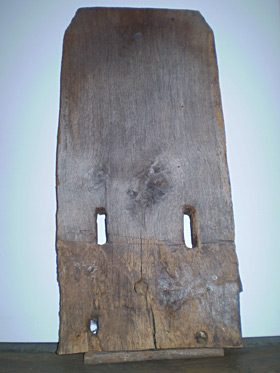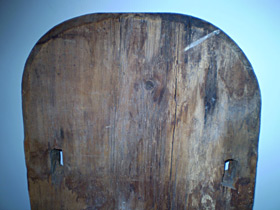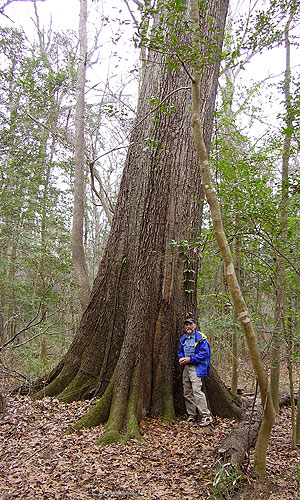Below are found two
venues of information on barns. The first concerns four
abstracts on a few diverse topics on barns. Each abstract
provides a broad overview of the presented topic. The
second is a long list that entails thirty articles of
various other topics on barns that have been written
by EBC and published since early 1992. After this list
is another list of nearly twenty articles that focuses
exclusively on Pennsylvania barns. More articles will
be added to both lists in the future.

This saved extended
oak anchor-beam tenon came from the now ruinous
dated 1766 Hoornbeck classic five-bay Dutch-American
barn located in Accord in Ulster County, New
York. At a length of nearly 21 inches this
is one of the longest tenons in any Dutch
related barn. |
|

The Muller circa
1790 four-bay classic Dutch-American barn
southwest of Middleburgh in Schoharie County,
New York and now ruinous had white pine anchor-beams
up to 22 inches in height. The extended tenon
shown here is 21 inches across. |
It is one thing to hew or hand form a timber by
use of a broad axe. But in separating the men from
the boys look to the joinery present in an early
building to really know the skill of a timber craftsman.
Joinery of course was utilized by all framers in
the erection of all ethnic timber framed buildings.
However, when one looks at Dutch-American barns
joinery or the process of uniting timbers together
will be seen in two principal manners. The first
way was by means of regular mortise and tenon joints
– such joints will be seen in virtually all
timber framed barns from Canada to the Deep South
and points west. These joints include wedged dovetailed,
half lapped, rafter connections and scarfed type
joints. The second way are joints seen only in Dutch
related barns – or anchor-beam joinery in
the very distinctive and diagnostic H-frames. These
tenons normally extend far beyond the posts they
are joined to and appear as salient tongues of wood.
These are the joints that only appear in certain
areas of New York and New Jersey barns and almost
nowhere else on the continent. |
| |
| |
| North American
barn builders did not randomly choose any species
of tree from local forests that supplied the timbers
they used in framing the barns they built. Builders
most often selected forest trees that supplied certain
qualities they were looking for. In the case of
Dutch-American barns two tree species were used
in the construction of perhaps 90 % of barns that
have been identified in the last nearly 35 years
– oak and pine. Pine (Pinus) – both
the white variety and the pitch variety was utilized
in the upper river valleys of eastern New York State
where tremendous sized trees were available from
the primeval forest. The big cross tie beams or
anchor-beams can attain up to two feet in depth.
In the lower river valleys oak (Quercus) was most
often used both the white and red varieties. Some
oak anchor-beams approach the two foot depth that
is more often seen in pine barns. Finally, in the
northern half of New Jersey barns are most often
made of oak. Perhaps 8 to 10 barns have anchor-beams
over 20 inches in height. The balance of tree species
used in these barns is – hemlock, chestnut,
tulip-tree and other hardwoods such as maple and
ash and a few other tree types. |
|
 This massive sized
oak tree could supply the greatest dimensioned anchor-beam
in any Dutch-American barn. Tree is located in Congaree
Natural Area in South Carolina.
This massive sized
oak tree could supply the greatest dimensioned anchor-beam
in any Dutch-American barn. Tree is located in Congaree
Natural Area in South Carolina. |
| |
Many of us like the ocean – you know the one
that is full of water. Well, there is another great
ocean that many of us have not paid too much attention
to – the ocean of barns that appear all around
us in Pennsylvania and other states for that matter.
These are the ones where we need to look - in our
own backyard. These are the old structures that
are just beckoning us to look at, the ones that
can tell us all kinds of things about the land and
the farmers who worked the land in the past 250
years. These are the connections to the past that
for many of us does not have too much reality. Just
go down almost any old country road or lane and
lurking behind some tall property trees or set off
in an old over-grown field will likely be an old
barn. But the next time you see an old barn safely
pull off (if you can) to the side of the road and
get out and really look at what is in front of you.
Maybe if you want try to discern what type and style
of barn you are looking at. It may be a fore-bay
two level barn or it may be a very old type ground
one level barn. But more importantly just absorb
what you are experiencing – try not to label
too much of anything. Just feel the spirit about
the barn and the old farm. That is first and foremost.
You can do it in your own back-yard. |
| |
If you are a native New Jerseyan like I am then
you have likely experienced quite a bit of jabbing
from other people – such as “New Jersey
is the armpit of the country.” Or –
“Well there’s a hell of a smell there.”
It never ends. There is one thing however that most
people are not aware of, not even native New Jerseyans.
With no kidding - the west central part of the state
has the greatest level of early barn diversity perhaps
in the entire North American continent. Why –
because it appears it was an area that was the great
cross-roads of various cultural traditions. It was
half way between the great area of New York and
New England and much of New Jersey and Pennsylvania
and areas south. In west central New Jersey there
remain to this very day – Dutch-American barns,
Pennsylvania German type fore-bay barns, swing beam
barns, stone ground barns and English side wall
entry barns. Especially with Dutch and German related
barns there is a riot of hybrid type barns. More
than 150 years ago they truly went crazy with all
kinds of barn building expressions. So people can
malign New Jersey all they want. Next time some
one puts their nose up at New Jersey tell them about
all the great early type barns near the Delaware
River in the central part of the state. Then see
what they say. |
| |

1– Westbrook Dutch Barn – Walpack Historical
Society (New Jersey) – March and June 1992 issues.
2– “Mammoth in Monmouth County” –
Timber Framing – June 1992.
3– “The Wemple Barn” – Timber
Framing – June 1992.
4– “Dutch Anchor-beams in Pennsylvania Barns”
– Dutch Barn Preservation Society Newsletter –
Spring 1993 Volume 6 No. 1.
5 – “The Case of the Vanishing Barn”
– Ulster Magazine – Winter 1995.
6– “What is a Dutch Barn Doing on English
Soil?” – Orange Times Past – October
1995 – Volume 1 – Number 5.
7– “Eighteenth Century Ulster County Lap-Dovetail
Dutch Barns” – Timber Framing – September
1996 – Number 41.
8 – “Joinery in Dutch-American Barns”
– Joiners Quarterly – Number 32 –
Aug/Sept/Oct 1996.
9– “Cantilevered Dutch-American Barns”
– Timber Framing – February 1997 –
Number 43.
10– “Framing Techniques as Clues to Dating
in Certain Pre-Revolutionary Dutch Barns: Major and
Minor Rafter Systems, Lapped Dove-tail Joinery, Verdiepinghs
and other Traits” – Material Culture –
Summer 1997 – Volume 29 Number 2.
11– “Dutch Barn Wood Species” –
Timber Framing – December 1997 – Number
46.
12 – “Ninety Degree Roof Rotations in New
Jersey Dutch Barns” – Material Culture –
Spring 1999 – Volume 31 – Number 1.
13 – “Dutch Barns in the Stony Lands of
Rockland County” – South of the Mountains
– October – December 1999 – Volume
43 – Number 4.
14 – “The Dutch Barn in America” –
de Halve Maen – Summer 2000 – Volume LXXIII
– Number 2.
15 – “The Dutch Barn in America –
Part Two” – de Halve Maen – Summer
2001 – Volume LXXIV – Number 2.
16 – “The Dutch Barn in America –
Part Three” – de Halve Maen – Fall
2001 – Volume LXXIV – Number 3.
17 – “Barn Diversity in New Jersey”-
Preservation Perspective – December 2003 –
Volume XXII – Number 4.
18 – “The
1720’s Peter Winne House – Making Progress
Every Day” – de Halve Maen – Spring
2004 – Volume 77 – Number 1.
19 – “Behind the Threshing Doors - An Inside
Look at Some of the Earliest Barns in Pennsylvania”
– Material Culture – Fall 2004 – Volume
36 – Number 2, Pg. 22 – 55.
20 – Article on
diversity of American barns appeared in four volume
“Encyclopedia of American Folklife” –
published ME Sharpe – 2006.
21 – “Abbott Lowell Cummings’ Prescience
and Dates for First Period Houses of Massachusetts Bay
Colony Using Dendrochronology” – Material
Culture – Fall 2006 – Volume 38 –
Number 2.
23 – “New World Dutch Barns of Bergen County,
New Jersey – Part One” Dutch Barn Preservation
Society Newsletter – Spring 2007.
24 – “Barns in Your Backyard – Neglected
and Forgotten” – Bucks-Lehigh Magazine –
September/October 2007- Volume 1 Issue 3 – Pages
27-28.
25 – Barn Tour Guide Booklet for Saucon Valley
Conservancy Barn Lecture and Tour – September
15th 2007.
26 – “New World Dutch Barns of Bergen County,
New Jersey – (Part two)” Dutch Barn Preservation
Society Newsletter – Fall 2007 – Number
20 – Issue 2
27 – “The Wemple Barn” – Timber
Framing – Number 89 September 2008
28 – “Barn Roof Timbers that Helped Build
Early German-American Culture in Pennsylvania –
Liegender Dachstahl and other Roof Supports” –
Der Reggeboge – Pennsylvania German Society –
Volume 42 – 2008 – Number 1 issue.
29 – “From the Distant Past – Early
Type Fackwerk German Ground Barn in Central New Jersey”
– Der Reggebogge – Volume 42 – 2008
– Number 1 issue.
30 – “Homestead of Jacobus Bruyn –
Pre-Revolutionary War era house and barn” –
HVVA Newsletter – November/December 2008 –
January 2009.
1 –
Review of Pennsylvania Barn (author - Robert Ensminger)
– Pennsylvania Folklife – early 1993.
2 – “Dutch Anchor-beams in Pennsylvania
Barns” – Dutch Barn Preservation Society
Newsletter – Spring 1993 Volume 6 No. 1.
3 – “The Pennsylvania Barn in New Jersey”
– Timber Framing – June ‘98 –
Number 48.
4 – “Two Singmaster Barns” –
Macungie Historical Society Newsletter – Fall
2002 – Volume 3 – Number 2/3 Issue.
5 – “Behind the Threshing Doors - An Inside
Look at Some of the Earliest Barns in Pennsylvania”
– Material Culture – Fall 2004 – Volume
36 – Number 2, Pg. 22 – 55.
6 – “John Heyl – Hale and Hearty at
101 Years Old” – Pennsylvania German Society
Newsletter – 2007.
7 – “Lower Macungie Township Historical
Society Barn Survey Documentations” – Number
1 – July 2007
8 – “Barns in Your Backyard – Neglected
and Forgotten” – Bucks-Lehigh Magazine –
September/October 2007- Volume 1 Issue 3 – Pages
27-28.
9 – “The Old Stone Barn at the Michael Heller
Farmstead” – Heller Homestead News –
Vo.14, Fall – 2007 – Number 2.
10 – Barn Tour Guide Booklet for Saucon Valley
Conservancy Barn Lecture and Tour – September
15th 2007.
11 – “The Old Stone Barn at the Michael
Heller Farmstead – Part Two” – Heller
Homestead News – Vol. 14 No. 3 – Winter
– 2007.
12 – Review of Second Edition of Robert F. Ensminger’s
book - Pennsylvania Barn – Its Origin, Classification
and Distribution – Der Reggeboge – Pennsylvania
German Society – 2006. Volume 40 – Number
1. Pgs 35 to 40. (Article published in 2007.)
13 – “The Old Berger Log Switzer in Shartlesville”
– Andulhey Adler, January 2008. Volume 4 –
Issue 1. Pgs 9 to 16.
14 – “ Stone Barns of the Oley Valley”
– for the Pennsylvania Barn and Farm Foundation
– in conjunction with the June 2008 Barn Conference
and Barn Tour held at Kutztown University and the Oley
Valley.
15 – Barn Tour Guide Booklet for Saucon Valley
Conservancy Barn Lecture and Tour – ten barns
and barn terms glossary – September 13th 2008.
16 – “Barn Roof Timbers that Helped Build
Early German-American Culture in Pennsylvania –
Liegender Dachstahl and other Roof Supports” –
Der Reggeboge – Pennsylvania German Society –
Volume 42 – 2008 – Number 1 issue.
17 – “From the Distant Past – Early
Type Fackwerk German Ground Barn in Central New Jersey”
– Der Reggebogge – Volume 42 – 2008
– Number 1 issue.
18 – “The Lerch Homestead Barn - Part One”
– Heller Homestead News – Volume 15, Winter
2008 Number 4.
19 – “Pennsylvania Barn – Only One
of Several Early Barn Types in North America.”
Pennsylvania Barn and Farm Foundation – Inaugural
Issue – December 2008.
|
|